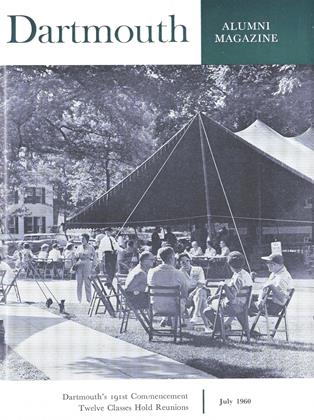Edited, with an introduction, by Edward Connery Lathem'51. Brattleboro, Vt.: Stephen Greene Press,i960. 223 pp. $4.50.
The purpose of this anthology is summed up in its subtitle: "The Man Behind the Myth." Mr. Lathem, who has studied the career and character of Calvin Coolidge for some years, knows how great a variance there is between the real Calvin Coolidge and the public image of him, created largely by an American press that found "Silent Cal" good copy for the so-called human interest stories that make better reading when not hamstrung by too strict adherence to the facts. So he has put together, with his own introductory chapter, the written reports and judgments of 36 persons who knew Coolidge more or less intimately and thus had a firsthand basis for what they thought of him. The reader who begins the book with the popular image of Coolidge in mind is pretty-certain to be surprised as he goes along and to end up with a quite different concept of the man who did not choose to run. The book successfully fulfills its purpose of throwing light on the man behind the myth.
In compiling his anthology Mr. Lathem has taken care to include critics as well as intimates and admirers of Calvin Coolidge. Walter Lippmann and H. L. Mencken, for example, were not impressed. Others represented in the book range from the President's wife, Grace Coolidge, to his Northampton neighbors and his White House mail clerk. There are writings by Frank Stearns, Kenneth Roberts, Gamaliel Bradford, Herbert Hoover, Bernard Baruch, Mark Sullivan, Will Rogers, Bruce Barton, Alfred E. Smith and Clarence Day, to name the more famous. The total effect of the 36 different points of view is persuasive that Calvin Coolidge was indeed far different from the popular myth. Perhaps the two most startling discoveries about him are that he had a delightful, dry sense of humor and probably played along to some extent with the public caricature of himself, and that far from being silent Cal, he was a wide-ranging conversationalist in the right circumstances and could on occasion be quite garrulous.
One of the longest and most interesting recollections is that of Colonel Starling of the Secret Service who walked with President Coolidge nearly every morning. The thesis of the book is almost undermined, however, by the story of how the President took Starling into the White House kitchen one morning and made him a cheese sandwich. After commenting that probably no other President of the United States had ever made Starling a cheese sandwich before, Coolidge added, "And I have to furnish the cheese too."
Meet Calvin Coolidge is another example of Mr. Lathem's intelligent, careful work as scholar and editor. His anthology not only has its own intrinsic interest for the general reader, but it also has a decided historical usefulness in helping to delineate the true character and personality of one of the most intriguing and paradoxical figures in American political and social history.
 View Full Issue
View Full Issue
More From This Issue
-
 Feature
FeatureThe Disinterested Citizen and the Maintenance of Freedom
July 1960 By WHITNEY NORTH SEYMOUR, LL.D. '60 -
 Feature
FeatureThe Fifty-Year Address
July 1960 By ANDREW J. SCARLETT '10 -
 Feature
FeatureHONORARY DEGREE CITATIONS
July 1960 -
 Feature
Feature1960 Commencement
July 1960 By D.E.O. -
 Feature
FeatureThe Image of the Educated Man
July 1960 By HARRISON CASE DUNNING '60 -
 Feature
FeatureThe Reunion Week
July 1960
C.E. WIDMAYER '30
Books
-
 Books
BooksEXPERT SKIING.
February 1961 -
 Books
BooksShelf Life
Sept/Oct 2002 -
 Books
BooksFaculty Books
July 1953 By LOUIS O. FOSTER -
 Books
BooksHEIR.
November 1968 By STEPHEN D. GELLER '62 -
 Books
BooksTHE LIFE SCIENCE LIBRARY BOOK OF MATHEMATICS.
MAY 1964 By WILLIAM E. SLESNICK -
 Books
BooksMAGIC SPADES
FEBRUARY 1930 By Wm. Stuart Messer



